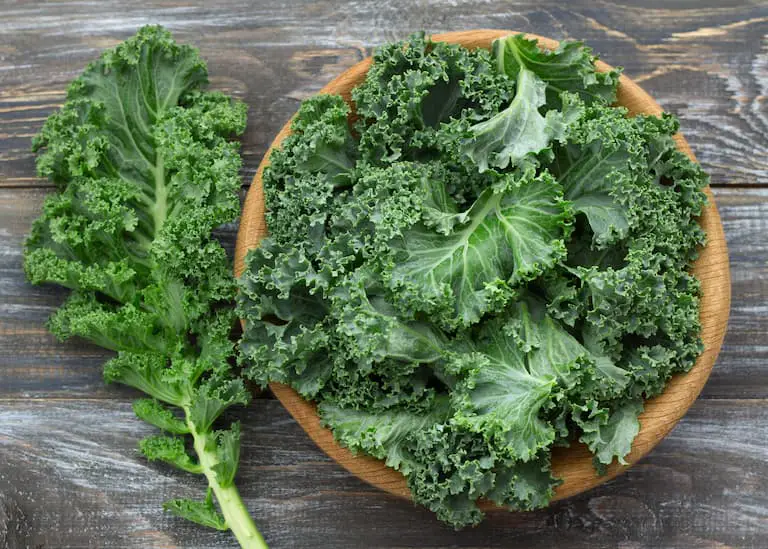Can You Freeze Kale? (You Sure Can! Here’s How)
Kale leaves are most delicious and tender when they’re fresh, and they only stay fresh for a week after harvesting. It’s not a good idea to leave them out in your garden for weeks, either. Fortunately, kale is an easy vegetable to preserve long-term in the freezer, and the process requires minimal preparation.
You can freeze kale to preserve it. Freezing kale is an excellent way to minimize food waste and it locks in its nutrients. To freeze kale, wash it and cut it into manageable pieces, blanch it, put it in a cold bath, flash-freeze in a tray, and then store it in an airtight container in the freezer.
Even if you don’t grow kale, you will want to store it up when it’s in season or on sale at the local store or farmers’ market. Luckily, kale is sturdy: it maintains most of its texture during freezing and defrosts quickly.
If you don’t have an immediate use for your fresh kale, read this article on how to freeze it and ways of using your frozen kale stash.

How To Freeze Kale
Kale is a hearty, versatile vegetable that freezes beautifully. If you want to freeze kale, do it immediately after you arrive home from the grocery store or right after you harvest it from your garden. You want to make sure that you freeze your kale when it is the freshest.
Here is how to freeze your kale and extend its shelf life:
1. Wash and Prepare The Kale
Wash and rinse the kale in a colander thoroughly until it’s free of all the grime and dirt, then remove the stems. You can chop the stems finely and use them alongside the leaves in any dish.
An easy way to remove the stem is to pinch the leaf at the base with your forefinger and thumb, then swiftly slide your fingers up the stem. The leaves should detach without much effort.
Next, cut up the kale into small, bite-sized portions.
2. Blanch The Kale
Blanching will halt enzyme activity and prepare the kale for long-term storage.
Place the kale in a pan or large pot of boiling water and firmly close the lid. Let it cook for two to three minutes until the leaves are tender and vibrantly green but not soft. Keeping it on the stove longer will make it wilt.
Alternatively, you can steam your kale by placing a steamer basket an inch or two (2.5 or 5 cm) over simmering water. Steam blanching takes slightly longer than the regular blanching time, but your kale will retain more nutritional value than with water blanching.
While your leaves are blanching, prepare an ice bath in a large bowl using half cold water and half ice. Some of the ice will melt once you add the hot kale, so you’ll need a lot of ice to keep the water cold. Set the bowl aside.
3. Drain, Cool, and Dry The Kale Leaves
When the kale is soft but bright green, drain the excess water in a colander and discard it down the drain. Use a pair of tongs or a slotted spoon to transfer the kale into the ice bath bowl. The ice water will stop the cooking process and retain the kale’s nutrients, color, and texture.
Let the kale leaves soak in the ice bath until they feel cold to the touch—about two minutes. Use tongs to move the leaves onto a dry kitchen or paper towel to dry them completely. You can also pass the leaves through a salad spinner to drain excess water before laying them out to dry.

4. Flash Freeze Your Kale Leaves
Line a cookie or baking sheet with parchment paper or a silicone mat. Arrange a single layer of the kale on the baking sheet and blot the vegetables dry with a clean, lint-free kitchen towel or paper towel. If your cookie sheet is too big for your freezer, place several batches on smaller flat surfaces such as dinner plates.
If you plan to use your frozen kale for sauces, smoothies, or soups, check out this method.
- Blend it to make a puree.
- Add a little water, if necessary, until you get the right consistency.
- Pour the puree into a sprayed muffin or ice cube tray.
- Freeze the kale for about two or three hours until firm.
- Remove them from the freezer.
Whether you’re flash freezing the kale on a baking sheet or pureed in a muffin or ice cube tray, place the tray into the freezer for a few hours until the kale is completely frozen.
5. Label and Store The Kale in The Freezer
Once frozen, transfer the kale portions to air-tight containers, freezer-safe plastic bags, or zip-top freezer bags. If you don’t have them at hand, I recommend the Hefty Slider Freezer Storage Bags on Amazon.com. These bags have a MaxLock track that makes sure your kale stays fresher for longer.
Tip: Remove as much air from the container as possible and store them flat in the freezer.
Label the packaging with the date to track how long your kale has been in the freezer. Frozen kale can last for six months.
How To Defrost Frozen Kale
To thaw your frozen kale, all you need is to remove the pack from the freezer and put it on the counter. It defrosts fast at room temperature, but if you’re in a hurry or you need a large amount, place the freezer bag or container in a cool water bowl.
The texture of thawed kale may not be as good as fresh, so you might want to use it in stir-fries and soups. It will work great in cooked dishes but not so much as kale chips, raw salads, or in recipes that require crunchy, fresh leaves.
You can add the frozen kale without thawing it to a soup or smoothie, or a cooked dish like a curry or a casserole. You might have to reduce the amount of liquid or increase the cooking time of the recipe—the frozen kale will add moisture as it thaws.
If you’re baking, defrost the kale and drain off all excess moisture before mixing it with the other ingredients. Extra liquid can change the consistency of your batter and affect the final dish.
Uses of Frozen Kale
Frozen kale is not ideal for salads or kale chips, but it has several other uses. These include:
- Stir-Fries: Frozen kale adds an instant kick to any stir-fry that needs greens. You can also mix your defrosted kale with red pepper flakes and sautèed garlic for a healthy, delicious side.
- Stews and soups: Add your frozen kale to stew or soup recipes right before serving. The kale will only need a little time to thaw and absorb other flavors since you have already cooked them when steaming or blanching.
- Pesto sauce: Defrost your frozen kale and combine it with lemon, pine nuts or walnuts, and parmesan cheese to make a vibrant, all-season pesto.
- Smoothies: Adding frozen kale to your green smoothies will give you extra nutrition and color.
Frequently Asked Questions About Frozen Kale
Does Frozen Kale Lose Nutritional Value?
Frozen kale does not lose nutritional value. Freezing kale preserves nutrients, and in its frozen state, it still packs as many minerals and vitamins as the fresh leaves. Some Vitamin C and B can dissolve during blanching, but the loss is negligible.
Freezing or blanching does not destroy fat-soluble nutrients like:
- Vitamin K
- Beta-carotene
- Minerals
- Fiber
Should You Wash Kale Before Freezing?
You should wash kale thoroughly before freezing. Leafy vegetables collect a lot of dirt and sand when in rainy or windy weather. This will also remove any chemicals and bugs hiding underneath the leaves.

It is less demanding to wash fresh leaves than clean frozen ones, so you’ll want to wash the kale prior to freezing it. Here’s how to give kale a thorough wash:
- Add two tablespoons (30 ml) of vinegar or salt to a large bowl of cold water.
- Give the leaves a good clean in the vinegar solution.
- Dry them with a salad spinner.
Can You Freeze Kale Without Blanching?
You can freeze kale without blanching. Unblanched kale leaves will retain their texture very well, but they take up a lot of freezer space, and won’t last as long in the freezer. If you freeze kale without blanching, plan to consume it within two months.
Unblanched kale can develop a bitter taste because the natural ripening enzymes are still active in the leaves.
Unblanched frozen kale will work best in soups and stews, where other flavors will likely overpower any bitterness. If your frozen kale is a stand-alone accompaniment, taste a bit of the frozen unblanched portion before freezing a large amount.
How Long Does Frozen Kale Last in The Freezer?
Frozen kale can easily last for six months to one year before its quality starts degrading. Frozen kale dries out slowly in the freezer, causing a decline in the texture and flavor over time.
Like other frozen leafy vegetables, you need to consume your frozen kale in under six months to enjoy the best texture and flavor. You can easily pick a pack of frozen kale and add it to your favorite recipe.
Can You Freeze Kale – Conclusion
Freezing kale is an excellent way to maximize the shelf life of this delicate vegetable. When it is in season, you can purchase it in bulk with peace of mind. Simply stock it up in your freezer, and enjoy it whenever you please.






